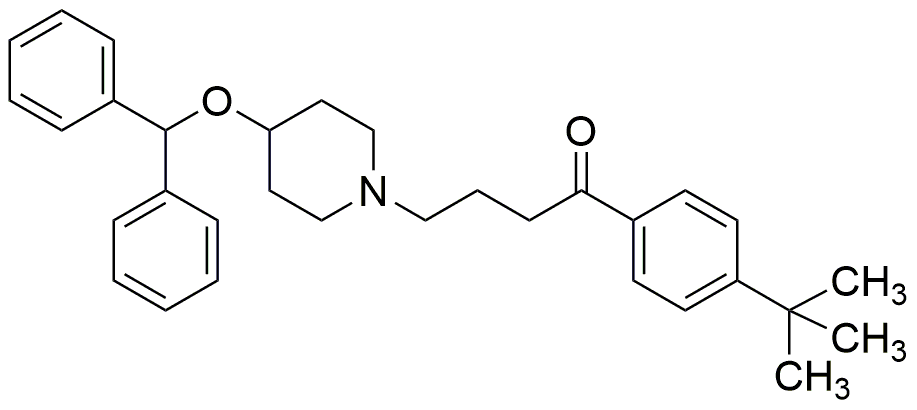Ebastine is widely utilized in research focused on:
- Allergy Relief: Commonly used as an antihistamine, it effectively alleviates symptoms of allergic rhinitis and urticaria, providing relief for patients suffering from seasonal allergies.
- Pharmaceutical Formulations: Its properties make it a key ingredient in various over-the-counter medications, enhancing the effectiveness of allergy treatments while minimizing drowsiness compared to older antihistamines.
- Clinical Research: Frequently studied in clinical trials to evaluate its efficacy and safety, contributing to advancements in allergy management and improving patient outcomes.
- Dermatological Applications: Used in topical formulations for skin allergies, it helps reduce inflammation and itching, making it beneficial in dermatology practices.
- Combination Therapies: Often combined with other medications to enhance therapeutic effects, it is particularly useful in multi-drug regimens for complex allergy cases.
Informations générales
Propriétés
Sécurité et réglementation
Applications
Ebastine is widely utilized in research focused on:
- Allergy Relief: Commonly used as an antihistamine, it effectively alleviates symptoms of allergic rhinitis and urticaria, providing relief for patients suffering from seasonal allergies.
- Pharmaceutical Formulations: Its properties make it a key ingredient in various over-the-counter medications, enhancing the effectiveness of allergy treatments while minimizing drowsiness compared to older antihistamines.
- Clinical Research: Frequently studied in clinical trials to evaluate its efficacy and safety, contributing to advancements in allergy management and improving patient outcomes.
- Dermatological Applications: Used in topical formulations for skin allergies, it helps reduce inflammation and itching, making it beneficial in dermatology practices.
- Combination Therapies: Often combined with other medications to enhance therapeutic effects, it is particularly useful in multi-drug regimens for complex allergy cases.
Documents
Fiches de données de sécurité (FDS)
La FDS fournit des informations de sécurité complètes sur la manipulation, le stockage et l’élimination du produit.
Spécifications du produit (PS)
Le PS fournit une description complète des propriétés du produit, notamment sa composition chimique, son état physique, sa pureté et les exigences de stockage. Il détaille également les plages de qualité acceptables et les applications prévues du produit.
Certificats d'analyse (COA)
Recherchez des certificats d'analyse (COA) en saisissant le numéro de lot du produit. Les numéros de lot et de lot se trouvent sur l'étiquette d'un produit, après les mots « Lot » ou « Lot de fabrication ».
Numéro de catalogue
Numéro de lot/série
Certificats d'origine (COO)
Ce certificat d'exploitation confirme le pays dans lequel le produit a été fabriqué, et détaille également les matériaux et composants utilisés et s'il est issu de sources naturelles, synthétiques ou autres sources spécifiques. Ce certificat peut être requis pour les douanes, le commerce et la conformité réglementaire.
Numéro de catalogue
Numéro de lot/série
Fiches de données de sécurité (FDS)
La FDS fournit des informations de sécurité complètes sur la manipulation, le stockage et l’élimination du produit.
DownloadSpécifications du produit (PS)
Le PS fournit une description complète des propriétés du produit, notamment sa composition chimique, son état physique, sa pureté et les exigences de stockage. Il détaille également les plages de qualité acceptables et les applications prévues du produit.
DownloadCertificats d'analyse (COA)
Recherchez des certificats d'analyse (COA) en saisissant le numéro de lot du produit. Les numéros de lot et de lot se trouvent sur l'étiquette d'un produit, après les mots « Lot » ou « Lot de fabrication ».
Numéro de catalogue
Numéro de lot/série
Certificats d'origine (COO)
Ce certificat d'exploitation confirme le pays dans lequel le produit a été fabriqué, et détaille également les matériaux et composants utilisés et s'il est issu de sources naturelles, synthétiques ou autres sources spécifiques. Ce certificat peut être requis pour les douanes, le commerce et la conformité réglementaire.


